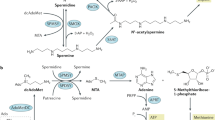Summary
The objective of this work was to study certain metabolic aspects of fluorine-substituted analogues of natural polyamines in healthy experimental animals, with the aim of exploring their potential application as tumor markers. Tissue polyamine concentrations were more effectively depleted by combined treatment with D,L-α-difluoromethylornithine, an irreversible inhibitor of ornithine decarboxylase, and N 1,N 4-bis-allenylputrescine, an inactivator of polyamine oxidase, than with either inhibitor alone. This suggests the general importance of polyamine interconversion as a metabolic source of putrescine. Administration of 2,2-difluoroputrescine after 2 weeks pretreatment with the two inhibitors caused the formation of 6,6-difluorospermidine and 6,6-difluorospermidine in nearly all tissues. Highest concentrations of the chain-fluorinated polyamines were observed in the small intestine. At 24 h after 2,2-difluoroputrescine administration the amount was about 8% of the normal endogenous polyamine pool in the small intestine, but lower in all other tissues. Replenishment of endogenous polyamine pools is a relatively slow process. Approximately 9 days after cessation of treatment with the two inhibitors normal values had been reestablished. The rate of formation of endogenous polyamines was not affected by the presence of their difluoro analogues. Elimination of the chain-fluorinated polyamines from tissues seems not to follow normal polyamine metabolic patterns. Their most rapid elimination coincides with the enhancement of endogenous polyamines, indicating that the fluoro analogues are displaced by the natural polyamines. Most of the 2,2-difluoroputrescine was rapidly excreted in the urine, and formation of a conjugate was detected. 6.6-Difluorospermidine was also a urinary excretion product. However, the metabolic fate of 6,6-difluorospermine could not be clarified. It was not found in urine, either free or as conjugate. The relatively low accumulation of chain-fluorinated polyamines, together with their rapid elimination from normal tissues are characteristics which together with their previously established selective uptake into rapidly proliferating tissues recommend them as potential tumor markers that can be determined by 19F-NMR spectroscopy.
Similar content being viewed by others
References
Alhonen-Hongisto L, Seppänen P, Hölttä E, Jänne J (1982) Replacement of natural polyamines by cadaverine and its aminopropyl derivatives in Ehrlich ascites carcinoma cells. Biochem Biophys Res Commun 106:291–297
Antrup H, Seiler N (1980) On the turnover of polyamines spermidine and spermine in mouse brain and other organs. Neurochem Res 5:123–143
Bey P (1978) Substrate-induced irreversible inhibition of α-amino acid decarboxylases. Application to glutamate, aromatic-L-α-amino acid and ornithine decarboxylase. In: Seiler N, Jung MJ, Koch-Weser J (eds) Enzyme-activated irreversible inhibitors. Elsevier/North-Holland Biomedical Press, Amsterdam, pp 27–41
Bey P, Bolkenius FN, Seiler N, Casara P (1985) N-2,3-Butadienyl-1,4-butanediamine derivatives: potent irreversible inactivators of mammalian polyamines oxidase. J Med Chem 28:1–2
Bolkenius F, Seiler N (1987) On the role of polyamine reutilization. Depletion of cellular stores of polyamines in non-proliferating tissues. Biochim Biophys Acta 923:125–135
Bolkenius FN, Bey P, Seiler N (1983) Specific inhibition of polyamine oxidase in vivo is a method of the elucidation of its physiological role. Biochim Biophys Acta 839:69–76
Chaney JE, Kobayashi K, Goto R, Digenis GA (1983) Tumor selective enhancement of radioactivity uptake in mice treated with α-difluoromethylornithine prior to administration of 14C-putrescine. Life Sci 32:1237–1241
Gerhart F, Mamont PS, Seiler N, Baillon J (1987) Syntheses and biochemical properties of geminal difluoropolyamines. J Med Chem (in press)
Mamont PS, Duchesne M-C, Joder-Ohlenbusch A-M, Grove J (1978) Effects of ornithine decarboxylase inhibitors on cultured cells. In: Seiler N, Jung MJ, Koch-Weser J (eds) Enzyme-activated irreversible inhibitors. Elsevier/North-Holland Biomedical Press, Amsterdam, pp 43–52
Mamont PS, Danzin C, Wagner J, Siat M, Joder-Ohlenbusch A-M, Claverie N (1982) Accumulation of decarboxylated S-adenosyl-L-methionine in mammalian cells as a consequence of the inhibition of putrescine biosynthesis. Eur J Biochem 123:499–504
Persson L, Oredsson SM, Anehus S, Heby O (1985) Ornithine decarboxylase inhibitors increase the cellular content of the enzyme: implications for translational regulation. Biochem Biophys Res Commun 131:239–245
Sarhan S, Knödgen B, Gerhart F, Seiler N (1987) Chain-fluorinated polyamines as tumor markers. I. In vivo transformation of 2,2-difluoroputrescine into 6,6-difluorospermidine and 6,6-difluorospermine. Int J Biochem 19:843–852
Seiler N (1987) Inhibition of enzymes oxidizing polyamines. In: McCann P, Pegg AE, Sjoerdsma A (eds) Inhibition of polyamine metabolism. Academic Press, New York, pp 49–77
Seiler N, Al-Therib MJ (1974) Putrescine catabolism in mammalian brain. Biochem J 144:29–35
Seiler N, Knödgen B (1985) Determination of polyamines and related compounds by reversed phase high-performance liquid chromatography: improved separation systems. J Chromatogr 339:45–57
Seiler N, Knödgen B, Bink G, Sarhan S, Bolkenius F (1983) Diamine oxidase and polyamine catabolism. Adv Polyamine Res 4:135–154
Seiler N, Bolkenius FN, Bey P, Mamont PS, Danzin C (1985a) Biochemical significance of inhibition of polyamine oxidase. In: Selmeci L, Brosnan ME, Seiler N (eds) Recent progress in polyamine research. Akademiai kiado, Budapest, pp 305–319
Seiler N, Bolkenius FN, Knödgen B (1985b) The influence of catabolic reactions on polyamine excretion. Biochem J 225:219–226
Author information
Authors and Affiliations
Additional information
Dedicated to Professor Werner Kunz on the occasion of his 65th birthday
Rights and permissions
About this article
Cite this article
Seiler, N., Sarhan, S., Knödgen, B. et al. Chain-fluorinated polyamines as tumor markers. J Cancer Res Clin Oncol 114, 71–80 (1988). https://doi.org/10.1007/BF00390488
Received:
Accepted:
Issue Date:
DOI: https://doi.org/10.1007/BF00390488




